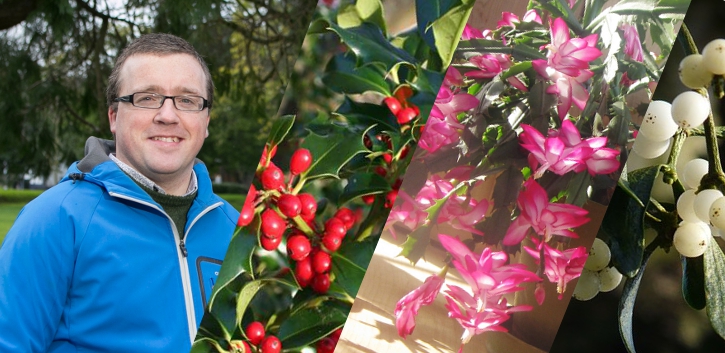2014 Press Releases
A Mayflower at Christmas?

Dr Eoin Lettice recently published a series of article on the plants of Christmas for the Irish Independent's 'Science of Christmas' supplement. To grow your festive spirit, read on!
(Reproduced courtesy of The Irish Independent/Katherine Donnelly - originally appeared in the supplement 'Science of Christmas' published 11 December 2014)
One of the most fascinating aspects of plants is the way they have become embedded in human culture and society. This is, perhaps, most evident at this time of year. From the Christmas Tree to Brussels Sprouts, plants are as much a part of Christmas as Santa himself.
Kissing under the mistletoe
If you’re lucky, you might just get a kiss under the mistletoe this year. Viscum album is what’s known as a hemi-parasite. That means it derives nutrients and water from a host plant, whilst also photosynthesising to harness sunlight for energy. It’s a sort of middle ground between being completely parasitic and completely free-living.
Mistletoe can parasitise over 200 different tree and shrub species and can ultimately kill these plants. The plant is poisonous to humans, yet lots of animals can overcome its toxins and depend on it for food in the wild.
It’s really odd then that a poisonous parasite would be at the centre of such a romantic tradition.
The plant has featured in folklore since Greek mythology and these days can be found hung in homes around the world in the hope of a quick kiss. The reasons for this are unclear but certainly the Greek naturalist Pliny the Elder (23 to 79 BC) recorded the widely held belief that because the mistletoe stayed green during the winter (it’s an evergreen) and the host tree generally lost its leaves, that the mistletoe somehow contained the ‘life’ of the tree. This connection with life and fertility meant it got caught up with the tradition of Christmas and kissing.
Holly wears the crown
The red and green colours of holly (Ilex aquifolium) have become the quintessential Christmas colour combination. Since pre-Christian times, it’s had an association with winter; when the red fruits and dark-green, foliage are at their peak.
In fact, there are about 400 species of holly around the world. Eighty of them are considered threatened in the wild. The bright red fruits are attractive to birds who eat them and deposit seed elsewhere in their droppings, often under trees. For some plants, germinating in the shade would be a problem. Not so for holly which is very shade tolerant. So much so that it is becoming a real problem in forested areas where it is not native, including the US.
Holly is dioecious, which means that it has separate male and female plants. The distinctive red berries (which are mildly toxic to humans) are produced only by female plants and only when both male and female plants are grown together.
Its attractiveness as a Christmas decoration means that in some places it is endangered. This year, Killarney National Park has had to organise special patrols to prevent people chopping down whole holly trees for the lucrative Christmas market. One of Ireland’s few native evergreen trees, it has become a victim of its own popularity.
Christmas Cactus
The mountains of Brazil might be the last place we imagine when we think about Christmas.
However, the Christmas cactus (Schlumbergera buckleyi) is native to Brazil where it lives as an epiphyte – that’s a plant that grows on another plant. It’s not a parasite (like mistletoe) because it doesn’t take nutrients from the host plant. It just thinks it’s a really nice place to hang out.
The green parts aren’t technically leaves. They are a sort of modified stem that are flattened to increase the amount of sunlight that the plant can absorb. The more sunlight it collects, the more energy it has for growing.
The flowers are interesting too as they have evolved to attract hummingbirds to transfer pollen from one flower to another in order to produce seed. They come in a range of colours, from white to red and deep purple.
While in the northern hemisphere the plant is known as the Christmas cactus and closely associated with this time of year, down in Brazil it’s often called Flor de Maio (the May flower) because of the time of year it flowers in their winter.
If you want to grow your own cactus, twist off one or two stem segments, let them dry out for a few days and then plant the ‘cut’ end, about 1cm deep in a simple potting mix. Don’t plant them too deep and have patience. They’ll take about 12 weeks to root but by next Christmas you’ll have lots of free plants to use as gifts!
Dr Eoin Lettice is a lecturer in Plant Science at UCC.
Today's @Independent_ie & @IrishResearch 'Science of Christmas' supplement features BEES' Eoin Lettice @ucc #scixmas pic.twitter.com/sgNp4pJM1C
— School of BEES, UCC (@uccBEES)
December 11, 2014
No less than 6 UCC staff contribute to today's @Independent_ie @SmartFuturesIE 'The Science of Christmas' supplement pic.twitter.com/zpKM5TWdVC
— UCC Ireland (@UCC)
December 11, 2014
